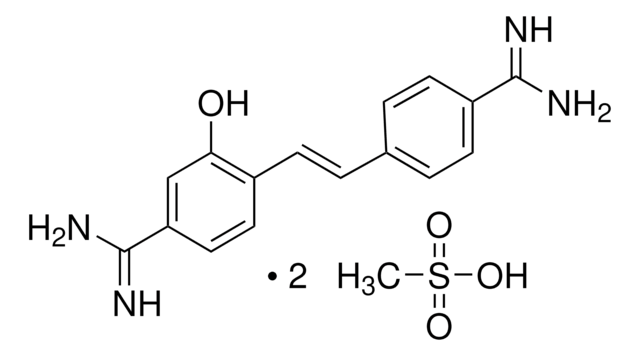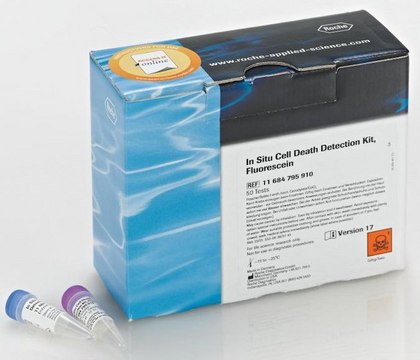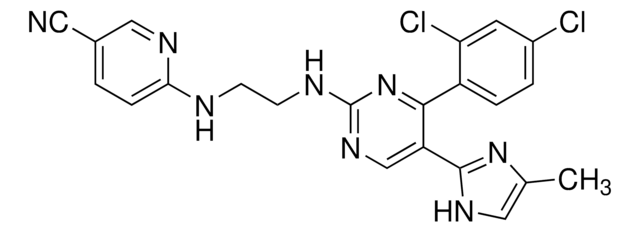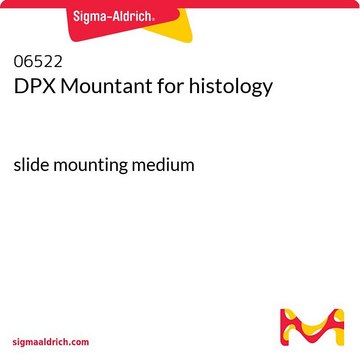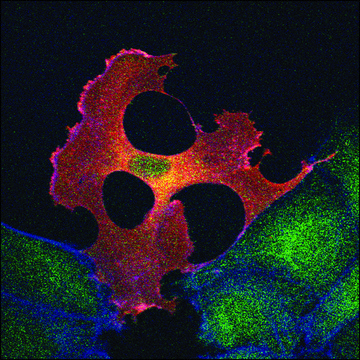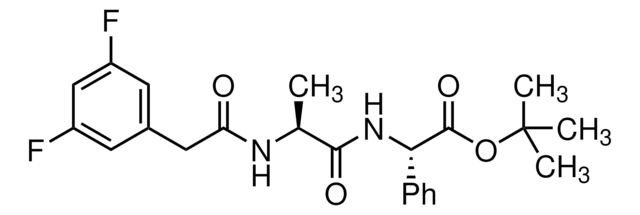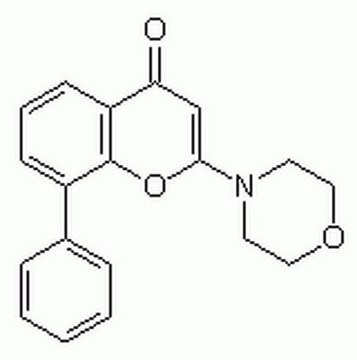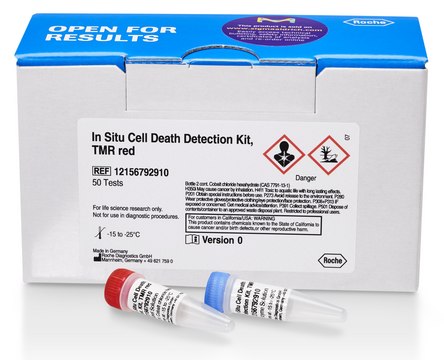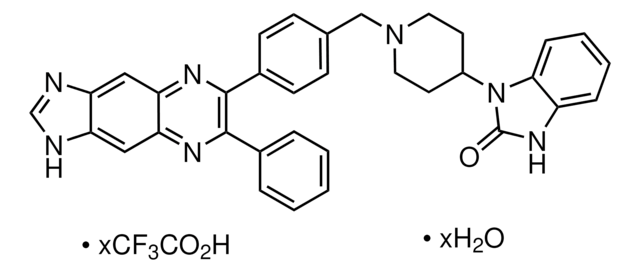Recommended Products
form
powder
mol wt
Mw 823 Da
manufacturer/tradename
Chemicon®
Fluoro-Jade®
technique(s)
immunohistochemistry: suitable
fluorescence
λex 485 nm; λem 525 nm
shipped in
ambient
General description
Fluoro-Jade C, like its predecessors, Fluoro-Jade and Fluoro-Jade B, were found to stain all degenerating neurons, regardless of specific insult or mechanism of cell death. Therefore, the patterns of neuronal degeneration seen following exposure to either the glutamate agonist, kainic acid, or the inhibitor of mitochondrial respiration, 3-NPA, were the same for all of the Fluoro-Jade dyes. However, there was a qualitative difference in the staining characteristics of the three fluorochromes. Specifically, Fluoro-Jade C exhibited the greatest signal to background ratio, as well as the highest resolution. This translates to a stain of maximal contrast and affinity for degenerating neurons. This makes it ideal for localizing not only degenerating nerve cell bodies, but also distal dendrites, axons and terminals. The dye is highly resistant to fading and is compatible with virtually all histological processing and staining protocols. Triple labeling can be accomplished by staining degenerating neurons with Fluoro-Jade C, cell nuclei with DAPI and activated astrocytes with GFAP immunofluorescence. Fluoro-Jade is a registered trademark of Histo-Chem, Inc.
Fluoro-Jade C, like its predecessors, Fluoro-Jade and Fluoro-Jade B, were found to stain all degenerating neurons, regardless of specific insult or mechanism of cell death. Therefore, the patterns of neuronal degeneration seen following exposure to either the glutamate agonist, kainic acid, or the inhibitor of mitochondrial respiration, 3-NPA, were the same for all of the Fluoro-Jadeâ dyes. However, there was a qualitative difference in the staining characteristics of the three fluorochromes. Specifically, Fluoro-Jade C exhibited the greatest signal to background ratio, as well as the highest resolution. This translates to a stain of maximal contrast and affinity for degenerating neurons. This makes it ideal for localizing not only degenerating nerve cell bodies, but also distal dendrites, axons and terminals. The dye is highly resistant to fading and is compatible with virtually all histological processing and staining protocols. Triple labeling can be accomplished by staining degenerating neurons with Fluoro-Jade C, cell nuclei with DAPI and activated astrocytes with GFAP immunofluorescence.
APPEARANCE: Coffee brown to brick red powder.
MOLECULAR WEIGHT: 823
EXCITATION PEAK: 485 nm
EMISSION PEAK: 525 nm
FILTER SYSTEM: Fluorescein / FITC
SOLUBILITY: Highly soluble in water and bases, moderately soluble in alcohol and weak acids.
TOXICITY: Although the compound appears to be of low toxicity, it has not been extensively evaluated and therefore routine laboratory caution should be exercised. Not intended for human consumption.
APPEARANCE: Coffee brown to brick red powder.
MOLECULAR WEIGHT: 823
EXCITATION PEAK: 485 nm
EMISSION PEAK: 525 nm
FILTER SYSTEM: Fluorescein / FITC
SOLUBILITY: Highly soluble in water and bases, moderately soluble in alcohol and weak acids.
TOXICITY: Although the compound appears to be of low toxicity, it has not been extensively evaluated and therefore routine laboratory caution should be exercised. Not intended for human consumption.
Application
FLUORO-JADE C has been used in:
- Fluoro-Jade C staining: to observe the pathological outcome of photothrombotic model after stroke
- to determine the direct neuronal death
- to evaluate neuronal degeneration in penumbra
- for brain cells to identify the damaged cells
- to assess neuronal injury
Warning
Toxicity: Although the compound appears to be of low toxicity, it has not been extensively evaluated and therefore routine laboratory caution should be exercised. Not intended for human consumption.
Target description
823
Linkage
Replaces: AG325
Storage and Stability
The lyophilized powder should be stored well sealed at room temperature, preferable in a desiccator (due to its hygroscopic nature) for up to one year from date of receipt. The liquid stock solution (0.01%) in distilled water can be stored at 2-8°C for up to 3 months. The .0002-.0001% working solution in 0.1% acetic acid should be used within 4 hrs of preparation.
Analysis Note
Silica TLC (acetanitrile/water, 6/4) revealed the presence of two fluorescent spots, presumably corresponding to the di sulphate homologues. The presence of precursors or free fluorescein was not detected.
Legal Information
CHEMICON is a registered trademark of Merck KGaA, Darmstadt, Germany
FLUORO-JADE is a registered trademark of Histo-Chem, Inc.
Storage Class Code
11 - Combustible Solids
WGK
WGK 2
Flash Point(F)
Not applicable
Flash Point(C)
Not applicable
Certificates of Analysis (COA)
Search for Certificates of Analysis (COA) by entering the products Lot/Batch Number. Lot and Batch Numbers can be found on a product’s label following the words ‘Lot’ or ‘Batch’.
Already Own This Product?
Find documentation for the products that you have recently purchased in the Document Library.
Characterization of a bilateral penetrating brain injury in rats and evaluation of a collagen biomaterial for potential treatment.
Paul Z Elias,Myron Spector
Journal of Neurotrauma null
Increased seizure susceptibility in mice 30 days after fluid percussion injury
Mukherjee S, et al.
Frontiers in Neurology, 28-28 (2013)
An organotypic spinal cord slice culture model to quantify neurodegeneration.
Madhumitha Ravikumar,Seema Jain,Robert H Miller,Jeffrey R Capadona,Stephen M Selkirk
Journal of Neuroscience Methods null
Neural stem cell transplantation promotes behavioral recovery in a photothrombosis stroke model
Ma J, et al.
International Journal of Clinical and Experimental Pathology, 8(7), 7838-7838 (2015)
Transforming growth factor-beta 1 signaling regulates neuroinflammation and apoptosis in mild traumatic brain injury
Patel RK, et al.
Brain, behavior, and immunity, 64, 244-258 (2017)
Our team of scientists has experience in all areas of research including Life Science, Material Science, Chemical Synthesis, Chromatography, Analytical and many others.
Contact Technical Service
